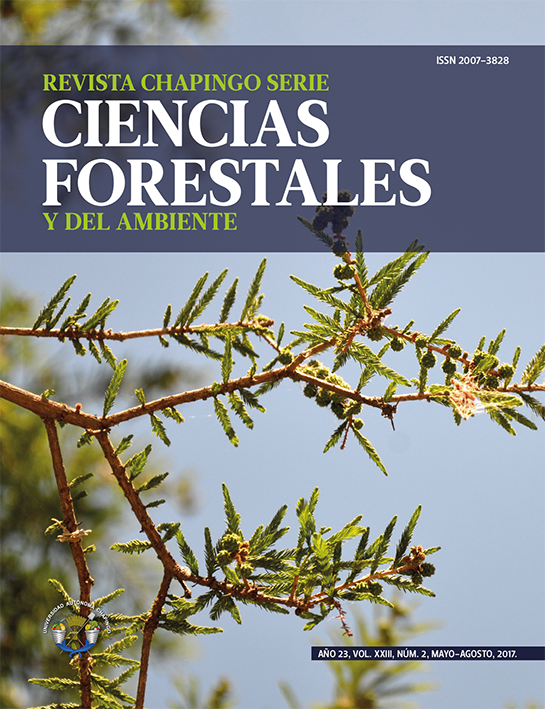##article.highlights##
- The effect of three levels of irrigation was evaluated in the hardening stage of Pinus oaxacana.
- Irrigation management affected root collar diameter, shoot and total dry weight.
- A reduction of irrigation between 30 and 45 % allows the production of hardened plants
- Hardening provides resistance to water stress in pine seedlings
- P. oaxacana regenerated its roots after a period of water stress
Abstract
Introduction: Plants should undergo a hardening process in the nursery to improve the survival of forest plantations in degraded areas.
Purpose of the study: The effect of three levels of irrigation was evaluated in the hardening stage on some morphological and physiological variables of Pinus oaxacana.
Materials and Methods: The treatments evaluated were three levels of irrigation and a control treatment. Irrigation was performed when the containers reduced their saturation weight by 30 % (frequent), 40-45% (medium) and 45-50% (low); in the control treatment, irrigation was applied every two or three days. The study used a randomized complete block design; each treatment consisted of 100 plants.
Results and Discussion: Morphological indicators with significant differences (P ≤ 0.05) among treatments were root collar diameter, shoot dry weight, and total dry weight. The physiological indicators using the root growth potential test showed no significant differences. Plants with frequent irrigation had greater diameter, shoot dry weight, and total dry weight.
Conclusions: A reduction of irrigation between 30 to 45 % in P. oaxacana allows the production of hardened plants, with greater possibility of success at the time of transplantation in the field.
References
Birchler, T., Rose, R. W., Royo, A., & Pardos, M. (1998). La planta ideal: revisión del concepto, parámetros definitorios e implementación práctica. Investigación Agraria: Sistemas y Recursos Forestales, 7, 109–121. http://compostamasvi.com/ebooks/plantaideal.pdf
Comisión Nacional Forestal (CONAFOR). (2010). Prácticas de reforestación. Jalisco, México: Autor.
Coopman, R. E., Jara, J. C., Escobar, R., Corcuera, L. J., & Bravo, L. A. (2010). Genotypic variation in morphology and freezing resistance of Eucalyptus globulus seedlings subjected to drought hardening in nursery. Electronic Journal Biotechnology, 13(1), 1–9. doi: https://doi.org/10.2225/vol13-issue1-fulltext-10
Dickson, A., Leaf, A. L., & Hosner, J. F. (1960). Quality appraisal of white spruce and white pine seedlings stock in nurseries. Forestry Chronicle, 36(1), 10–13. doi: https://doi.org/10.5558/tfc36010-1
Duryea, M. L. (1985). Evaluating seedling quality: Importance to reforestation. In M. L. Duryea (Ed.), Evaluating seedling quality: Principles, procedures, and predictive abilities of major tests (pp. 1–4). Corvallis, Oregon, USA: Forest Research Laboratory, Oregon State University. http://www.rngr.net/publications/evaluating/PDF.2003-10-27.2237/at_download /file +&cd= 1&hl=es&ct=clnk&gl=mx
Grossnickle, S. C. (2005). Importance of root growth in overcoming planting stress. New Forests, 30(2), 273–294. doi: https://doi.org/10.1007/s11056-004-8303-2
Landis, T. D. (2013). Conditioning nursery plants to promote hardiness and dormancy. In R. K. Dumroese, & T. D. Landis (Eds.), Forest nursery notes (pp. 5–14). Washington, DC, USA: USDA. http://www.rngr.net/publications/fnn/2013-winter/2013-winter-forest-nursery-notes/at_download/file
Pita, P., & Pardos, J. A. (2001). Growth, leaf morphology, water use and tissue water relations of Eucalyptus globulus clones in response to water deficit. Tree Physiolgy, 21(9), 599–607. doi: https://doi.org/10.1093/treephys/21.9.599
Planelles-González, R., Villar-Salvador, P., Oliet-Palá, J., & López-Arias, M. (2004). Efecto de tres niveles de estrés hídrico y dos periodos de aplicación sobre algunos parámetros de calidad functional de Quercus ilex L. y su desarrollo postrasplante. Cuadernos de la Sociedad Española de Ciencias Forestales, 17, 81–85. https://dialnet.unirioja.es/ejemplar/223445
Royo, A., Gil, L., & Pardos, J. A. (2001). Effect of water stress conditioning on morphology, physiology and field performance of Pinus halepensis Mill. seedlings. New Forests, 21(2), 127–140. doi: https://doi.org/10.1023/A:1011892732084
Statistical Analysis System (SAS Institute). (2002). The SAS system for Windows. Release version 9.0. Cary, NC, USA: Author.
Tinus, R. (1996). Root growth potential as an indicator of drought stress history. Tree Physiology, 16(9), 795–799. doi: https://doi.org/10.1093/treephys/16.9.795
Valladares, F., Vilagrosa, A., Peñuelas, J., Ogaya, R., Camarero, J. J., Corcuera, L., …Gil-Pelegrí, E. (2008). Estrés hídrico: ecofisiología y escalas de la sequía. En Valladares, F. (Ed.), Ecología del bosque mediterráneo en un mundo cambiante (2ª ed., pp. 165‒192). España: Organismo Autónomo Parques Nacionales.
Vilagrosa, A., Cortina, J., Rubio, E., Trubat, R., Chirino, E., Gil P., E., & Vallejo, V. R. (2005). El papel de la ecofisiología en la restauración forestal de ecosistemas mediterráneos. Investigación Agraria: Sistemas y Recursos Forestales, 14, 446−461. https://dialnet.unirioja.es/servlet/articulo?codigo=1341367
Villar-Salvador, P., Ocaña-Bueno, L., Peñuelas-Rubira, J. L., Carrasco-Manzano, I., Domínguez-Lerena, S., & Renilla-Estrada, I. (1997). Relaciones hídricas y potencial de formación de raíces en plántulas de Pinus halepensis Mill. sometidas a diferentes niveles de endurecimiento por estrés hídrico. Cuadernos de la Sociedad Española de Ciencias Forestales, 4, 81–92. http://www.magrama.gob.es/es/desarrollo-rural/temas/politica-forestal/endurecimie nto_ph1_tcm7-23450.pdf
Villar-Salvador, P., Peñuelas-Rubira, J. L., & Jacobs, D. F. (2013). Nitrogen nutrition and drought hardening exert opposite effects on the stress tolerance of Pinus pinea L. seedlings. Tree Physiology, 33(2), 221–232. doi: https://doi.org/10.1093/treephys/tps133
Villar-Salvador, P., Planelles, R., Oliet, J., Peñuelas-Rubira, J. L., Jacobs, D. F., & González, M. (2004). Drought tolerance and transplanting performance of holm oak (Quercus ilex) seedlings after drought hardening in the nursery. Tree Physiology, 24(10), 1147–1155. doi: https://doi.org/10.1093/treephys/24.10.1147

This work is licensed under a Creative Commons Attribution-NonCommercial 4.0 International License.
Copyright (c) 2017 Revista Chapingo Serie Ciencias Forestales y del Ambiente



